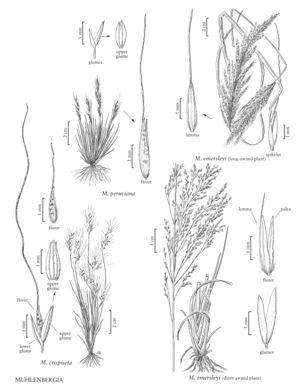Muhlenbergia crispiseta
Plants annual; tufted. Culms 7-16 cm. Sheaths longer than the internodes, scabridulous or smooth, margins membranous; ligules 1.3-2 mm, membranous, rounded; blades 1-5 cm long, 0.7-1.4 mm wide, flat or involute, scabridulous or smooth abaxially, shortly pubescent adaxially. Panicles 1.8-4.5 cm long, 1.5-3 cm wide, long-exserted; primary branches 1.5-2.8 cm, ascending; pedicels 0.4-2 mm, often curved, scabrous. Spikelets 1.7-2.2 mm. Glumes whitish, mostly smooth, scabrous on the veins; lower glumes 1.2-1.6 mm, 1-veined, acute; upper glumes 1.6-1.8 mm, wider than the lower glumes, 2-veined or 3-veined, truncate, 2-toothed or 3-toothed; lemmas 1.7-2.2 mm, lanceolate, widest near the middle, whitish with dark green patches, densely hairy on the calluses and lower portion of the lemma bodies, hairs to 0.5 mm, apices glabrous, acuminate, minutely bifid, awned, awns 8-18 mm, sinuous to crisped or curled, olive-green; paleas 1.1-1.7 mm, lanceolate, intercostal region loosely pilose on the proximal 2/3, apices acuminate; anthers 0.4-0.7 mm, purplish-red. Caryopses 0.5-1.1 mm, ellipsoid, brownish. 2n = 20.
Discussion
Muhlenbergia crispiseta grows on rock outcrops, in rocky drainages, and on white tablelands, on soils derived from calcareous parent materials in pine-oak and pinyon-juniper woodlands, at elevations of 1900-2600 m. It is basically a Mexican species, with a disjunct population in Brewster County, Texas.
Selected References
None.
Lower Taxa
"decumbent" is not a number.
